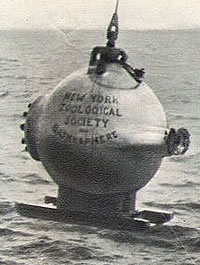
Sidebar: Changing the Face of Ocean Engineering
"The bathysphere was lowered more than a half mile on a test run, unmanned. It came up heavy and, as it turned out, full of water under extremely high pressure. Deck hands began to unscrew a large brass bolt at the center of the door. Jets of water screamed out. Suddenly, with no warning, the bolt tore loose and shot across the deck like a shell from a gun. "

William Beebe's bathysphere, on an expedition sponsored by National Geographic Society and New York Zoological Society.
Bill Broad described in his book, The Universe Below, a test leading up to a June 1930 dive by William Beebe, the first scientist to view the deep using a sphere-shaped vehicle tethered to a ship above.
Ocean engineering has made many strides since, yet the challenges of working at the bottom of the ocean means that much work is still conducted from ships by lowering dredges and instruments into the depths. Submersibles, some that carry scientists and others that operate by remote control, are of limited use because they are expensive and can't be launched in foul weather.
The challenges of engineering Neptune's seafloor, robotic network—at a reasonable price—are many, according to Pat Beauchamp, with NASA's Jet Propulsion Laboratory and Neptune's lead overseeing project engineering.
Having to rely on battery power for sensors has been the downfall of some previous attempts at long-term seafloor observations, Beauchamp says. Neptune will be powered via its cable network; however, the most likely power scheme, which works just fine on land, has never been tried on the seafloor anywhere.
Also, a system in the deep that's meant to operate for 30 or 40 years must have a lot of built-in reliability and resilience to corrosion from salt water, fluctuating temperatures, occasional seafloor "storms" and disruptions from the very earthquakes scientists are so eager to study.
To be successful, Neptune will have to be a combination of the latest advances in computer science, telecommunications and robotics with evolving capabilities in the power and sensor industries. Beauchamp says successes could prove useful to other countries, such as Japan, where they are keen to install equipment as an early warning system for earthquakes and tsunamis. It could also benefit industries using power and communications lines on the seafloor.—Sandra Hines
- Return to Waterworld: Part One
- Return to A Telescope Trained on 'Inner Space'
- Return to When Did Godzilla Topple?
- Return to December 2001 Table of Contents